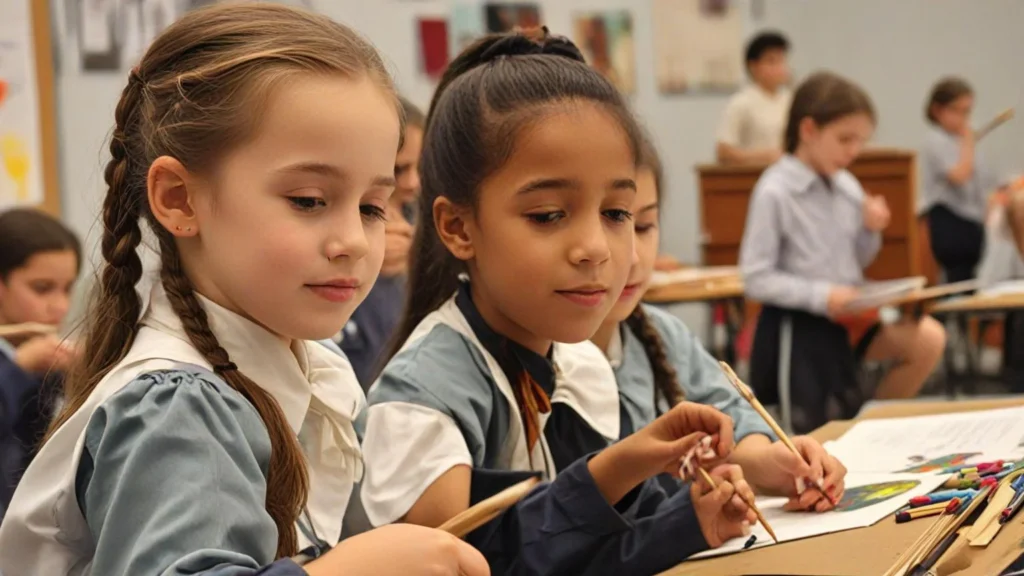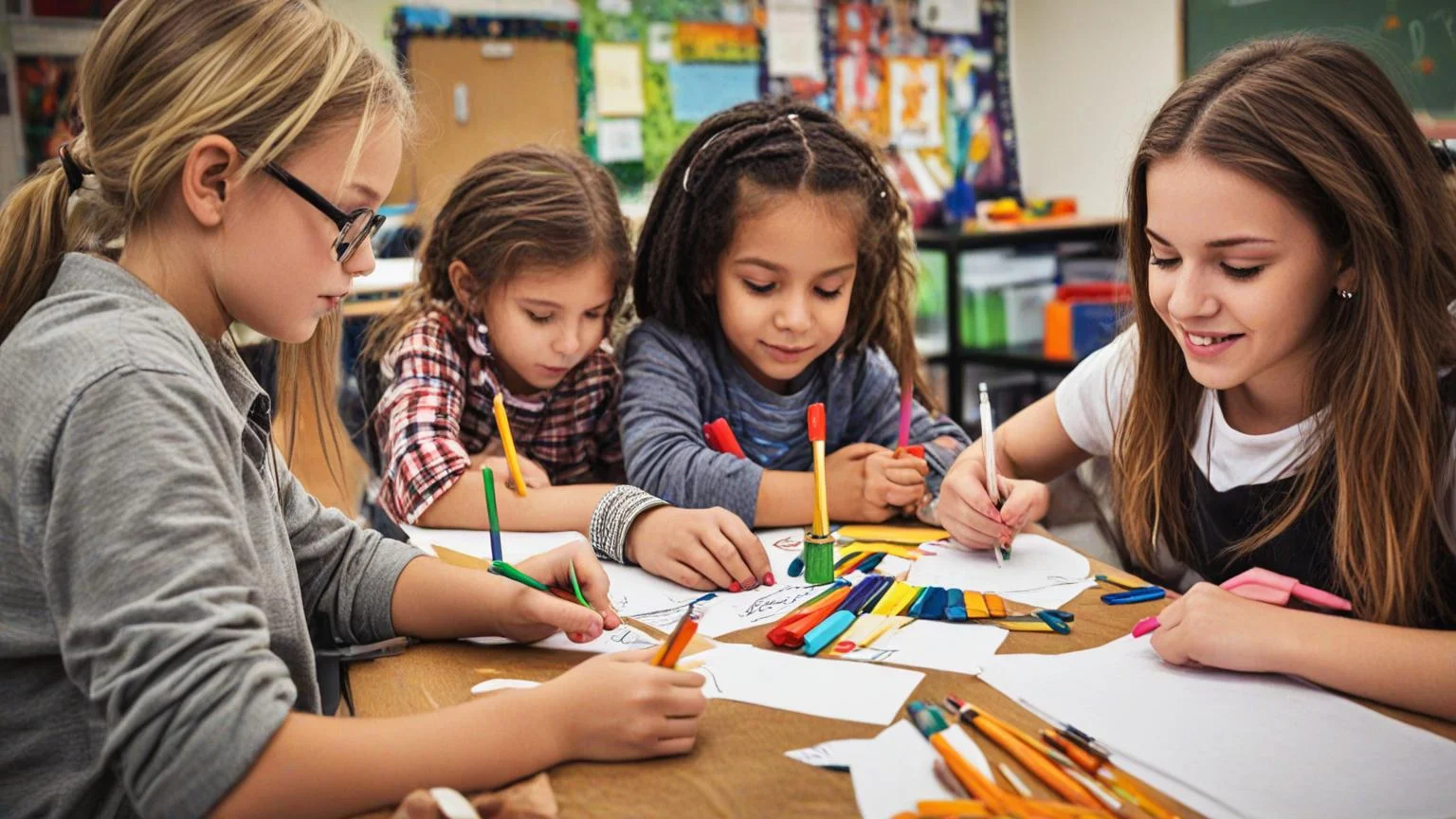Arts education, often an integral part of the school curriculum, encompasses visual arts, music, theater, and dance. Beyond mere creativity, arts education offers numerous benefits that extend to academic performance, personal development, and societal enrichment.
In this article, we will explore why arts education is beneficial, the value it holds, and how it positively impacts both individuals and communities. We will also discuss the pros and cons of including art education in school programs.
Why Is Art Education Beneficial?
Art education offers a wide array of benefits that support various aspects of students’ academic and personal growth. Here are several reasons why art education is beneficial:
Enhances Academic Performance
Explanation: Research shows that students engaged in arts education often exhibit improved academic performance across different subjects.
Supporting Evidence:
- Increased Test Scores: Studies have found that students involved in the arts score higher on standardized tests. For example, students who participate in music programs tend to perform better in math and reading.
- Improved Grades: Arts education can lead to better grades in core subjects. Students involved in theater or visual arts often develop skills that translate into improved classroom performance.
Example Studies:
- A study by The National Endowment for the Arts found that students who took part in the arts had higher academic achievements.
- The Arts Education Partnership reports that students involved in arts learning show better performance in reading and mathematics.
Develops Critical Thinking and Problem-Solving Skills
Explanation: Arts education fosters critical thinking and encourages students to approach problems from different angles.
Supporting Evidence:
- Creative Problem-Solving: Art projects often require students to think creatively and solve complex problems. This process enhances their ability to think critically and make reasoned decisions.
- Analytical Skills: Engaging with art helps students analyze and interpret various forms of expression, developing their analytical skills.
Example Activities:
- Project-Based Learning: Students create original art pieces, which involves planning, experimentation, and problem resolution.
- Art Critique: Analyzing artworks encourages students to express their opinions and support their ideas with evidence.
Fosters Emotional and Social Development
Explanation: Art education supports emotional expression and social interaction among students.
Supporting Evidence:
- Emotional Expression: Art provides a medium for students to express their feelings and emotions, which can lead to better emotional health.
- Social Skills: Group art projects promote collaboration and communication skills.
Example Activities:
- Collaborative Art Projects: Students work together on large-scale art pieces, developing teamwork and social skills.
- Art Therapy: Art can be used as a form of therapy to help students manage stress and emotional challenges.
Encourages Creativity and Innovation
Explanation: Art education encourages creative thinking, which is essential for innovation in various fields.
Supporting Evidence:
- Creative Thinking: Art projects encourage students to explore new ideas and think outside the box.
- Innovative Solutions: Students learn to approach challenges with creative solutions, which can benefit them in all areas of life.
Example Activities:
- Creative Art Challenges: Students are given open-ended art challenges that require innovative solutions.
- Design Projects: Students design new products or artistic concepts, fostering creativity and originality.
Supports Cultural Awareness and Appreciation
Explanation: Arts education exposes students to diverse cultures and perspectives.
Supporting Evidence:
- Cultural Exposure: Art education introduces students to various cultures and traditions through art forms from around the world.
- Cultural Appreciation: Understanding different artistic traditions promotes respect and appreciation for cultural diversity.
Example Activities:
- Art from Different Cultures: Students explore and create art based on different cultural traditions.
- Guest Artists: Inviting artists from diverse backgrounds to share their experiences and work with students.
What Is the Value of Arts Education?

Arts education holds significant value for individuals and society as a whole. Its value can be understood through the following perspectives:
Academic Value
Explanation: Arts education contributes to students’ academic success by reinforcing skills learned in other subjects.
Details:
- Academic Skills: Arts education supports literacy, numeracy, and critical thinking.
- Transferable Skills: Skills gained from arts education, such as problem-solving and creativity, are transferable to other academic areas.
Example: A student who learns to interpret and critique artworks may develop better analytical skills for literature or history.
Personal Value
Explanation: Arts education contributes to personal growth and self-expression.
Details:
- Self-Expression: Art provides a way for students to express themselves and explore their identities.
- Confidence Building: Creating and sharing art helps build self-esteem and confidence.
Example: Students who perform in a school play or exhibit their artwork gain confidence in their abilities and ideas.
Professional Value
Explanation: Arts education equips students with skills that are valuable in the workforce.
Details:
- Career Skills: Creativity, teamwork, and communication are essential skills in many professions.
- Career Opportunities: Arts education can lead to careers in the arts, education, and other fields where creative skills are in demand.
Example: Graduates from arts programs may become professional artists, art educators, or work in creative industries like advertising and design.
Societal Value
Explanation: Arts education benefits society by fostering cultural enrichment and community engagement.
Details:
- Cultural Enrichment: Arts education promotes cultural understanding and appreciation.
- Community Engagement: Arts programs often involve community outreach and collaboration.
Example: Community art projects and performances bring people together and strengthen community bonds.
How Might Art Education Be a Benefit to Society?

Art education offers numerous societal benefits, including:
Promotes Cultural Diversity and Inclusion
Explanation: Arts education fosters an appreciation for diverse cultures and promotes inclusivity.
Details:
- Cultural Awareness: Arts programs expose students to different cultures and perspectives.
- Inclusive Practices: Art education encourages diverse voices and perspectives.
Example: Schools that offer multicultural art programs help students learn about and appreciate different cultural traditions.
Supports Community Development
Explanation: Art education can contribute to community development and local engagement.
Details:
- Community Projects: Art initiatives often involve collaboration between schools and local organizations.
- Local Engagement: Arts programs can revitalize communities and create opportunities for local involvement.
Example: Community murals and art festivals bring people together and celebrate local culture.
Enhances Quality of Life
Explanation: Arts education enriches lives through cultural experiences and creative opportunities.
Details:
- Cultural Opportunities: Access to the arts enhances the quality of life for individuals and communities.
- Emotional Well-being: Art activities contribute to emotional health and well-being.
Example: Art classes and exhibitions provide enjoyable and enriching experiences for community members.
What Are the Pros and Cons of Art Education in Schools?
Pros of Art Education
| Pro | Description |
|---|---|
| Improves Academic Performance | Students in arts programs often show better academic results. |
| Fosters Creativity and Innovation | Encourages creative thinking and problem-solving skills. |
| Supports Emotional Development | Provides a healthy outlet for emotional expression and stress relief. |
| Enhances Social Skills | Group projects and performances develop teamwork and communication skills. |
| Builds Cultural Awareness | Exposes students to diverse cultures and artistic traditions. |
| Provides Career Opportunities | Opens doors to careers in the arts and related fields. |
| Strengthens Community Ties | Art initiatives promote community involvement and cultural enrichment. |
Cons of Art Education
| Con | Description |
|---|---|
| Perceived as Less Important | Arts education may be undervalued compared to core subjects like math and science. |
| Resource Intensive | Requires funding for materials, equipment, and qualified instructors. |
| Time Constraints | Limited class time for art education may lead to less focus on other subjects. |
| Not Always Inclusive | Arts programs may not always be accessible to all students due to various factors. |
| Potential for Inequality | Disparities in arts education resources between different schools or districts. |
Conclusion
Arts education plays a crucial role in the academic, personal, and societal development of students. Its benefits extend far beyond the classroom, contributing to improved academic performance, personal growth, and community enrichment. While there are challenges associated with art education, its overall impact is overwhelmingly positive.

